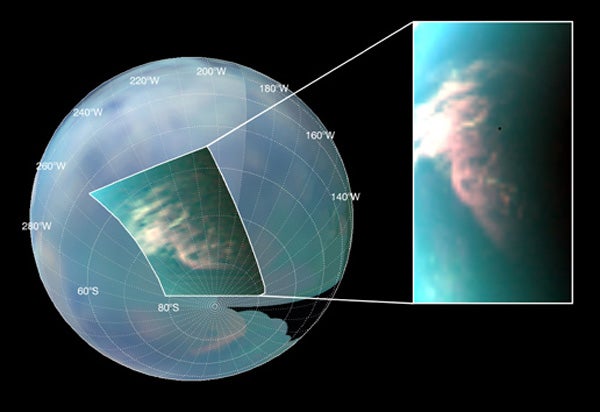Cloud chasers studying Saturn’s moon Titan say its clouds form and move much like those on Earth, but in a much slower, more lingering fashion.
Their forecast for Titan’s early autumn: warm and wetter.
Scientists with NASA’s Cassini mission have monitored Titan’s atmosphere for 3.5 years, between July 2004 and December 2007, and observed more than 200 clouds. They found that the way these clouds are distributed around Titan matches scientists’ global circulation models. The only exception is timing — clouds are still noticeable in the southern hemisphere while fall is approaching.
“Titan’s clouds don’t move with the seasons exactly as we expected,” said Sebastien Rodriguez of the University of Paris Diderot, in collaboration with Cassini visual and infrared mapping spectrometer team members at the University of Nantes, France. “We see lots of clouds during the summer in the southern hemisphere, and this summer weather seems to last into the early fall. It looks like Indian summer on Earth, even if the mechanisms are radically different on Titan from those on Earth. Titan may then experience a warmer and wetter early autumn than forecasted by the models.”
On Earth, abnormally warm, dry weather periods in late autumn occur when low-pressure systems are blocked in the winter hemisphere. By contrast, scientists think the sluggishness of temperature changes at the surface and low atmosphere on Titan may be responsible for its unexpected warm and wet, hence cloudy, late summer.
As summer changes to fall at the equinox in August 2009, Titan’s clouds are expected to disappear altogether. Circulation models, however, of Titan’s weather and climate predict that clouds at the southern latitudes don’t wait for the equinox and should have already faded out since 2005. Cassini was still able to see clouds at these places late in 2007, and some of them are particularly active at midlatitudes and the equator.
Titan is the only moon in our solar system with a substantial atmosphere, and its climate shares earthlike characteristics. Titan’s dense nitrogen-methane atmosphere responds much more slowly than Earth’s atmosphere, as it receives about 100 times less sunlight because it is 10 times farther from the Sun. Seasons on Titan last more than 7 Earth years.
Scientists will continue to observe the long-term changes during Cassini’s extended mission, which runs until the fall of 2010. Cassini is set to fly by Titan on June 6.










